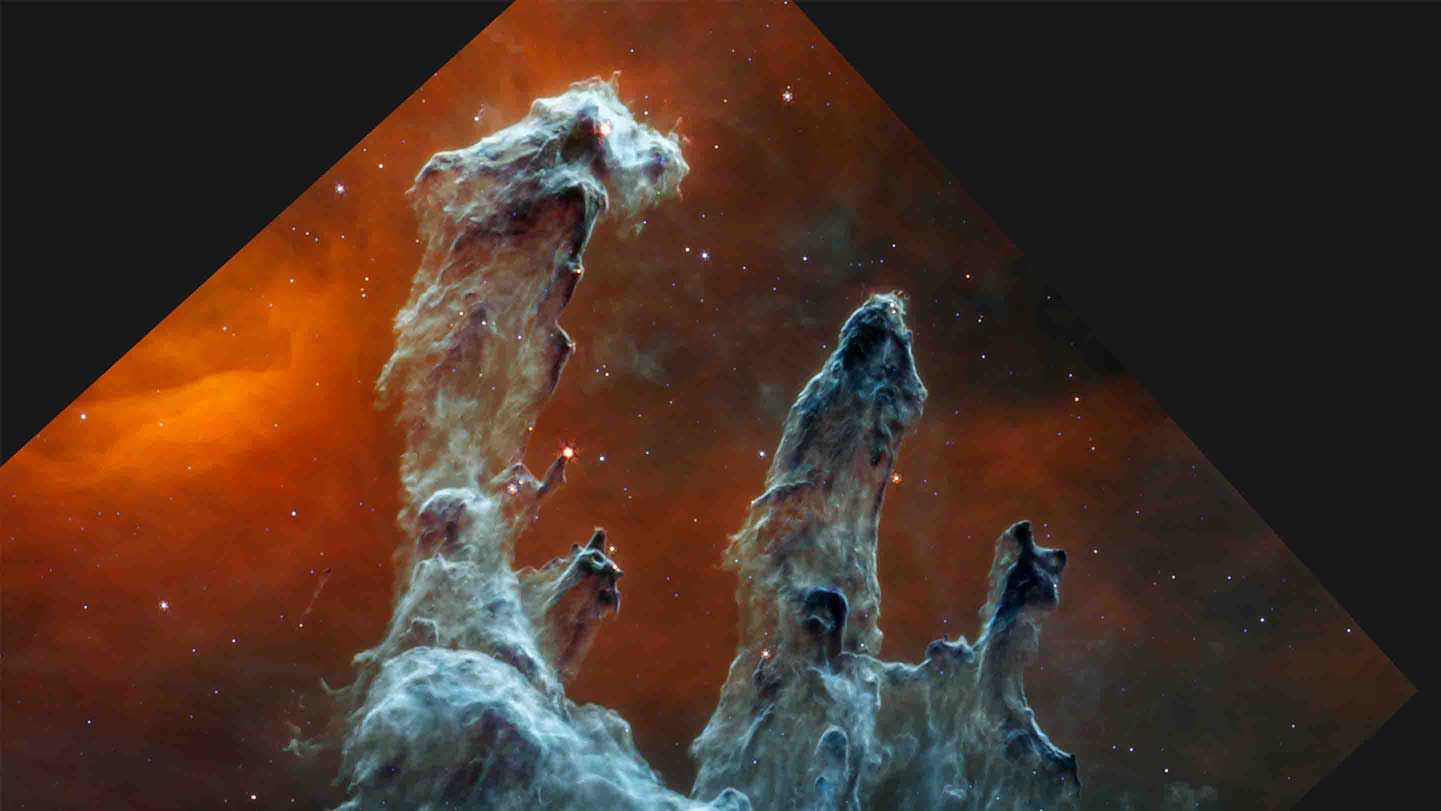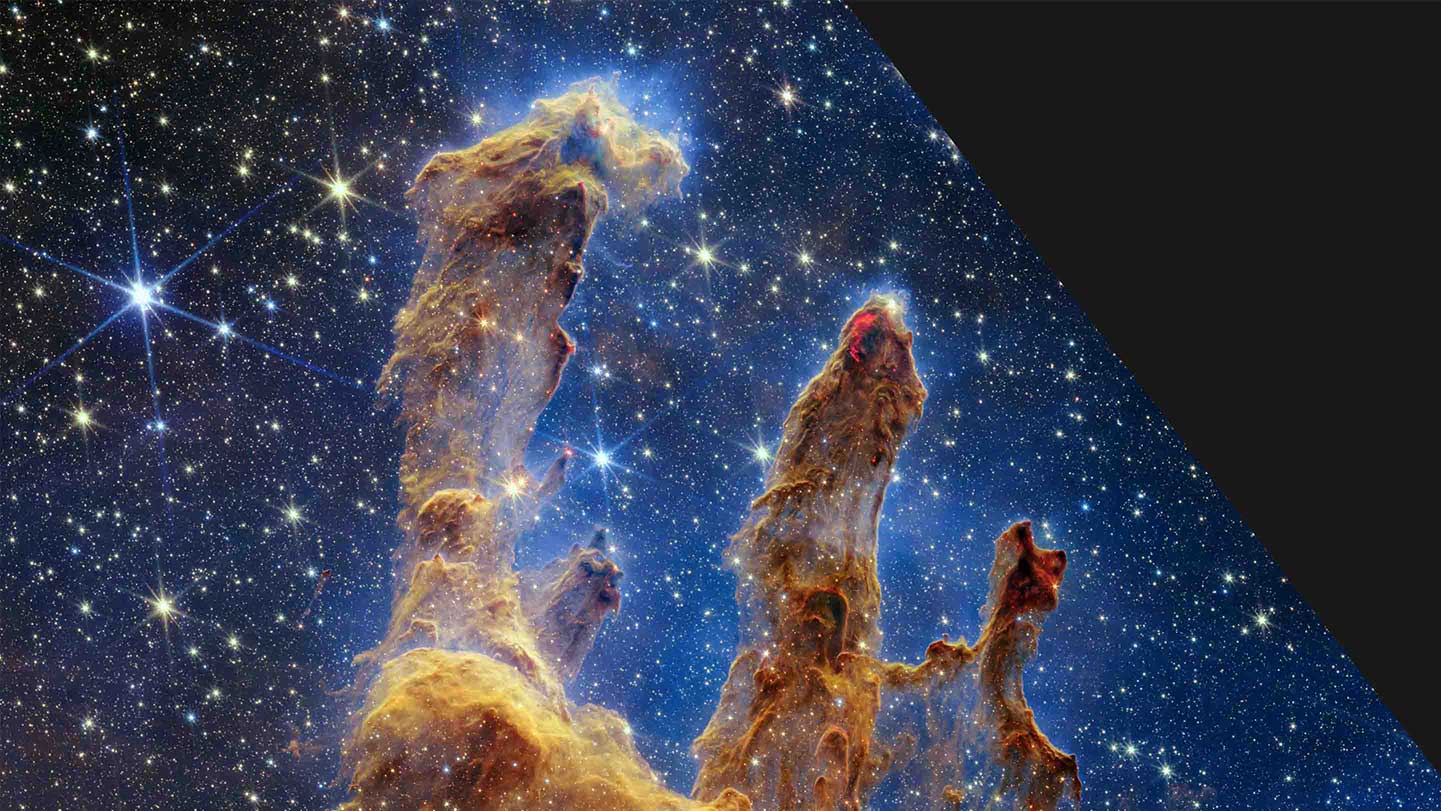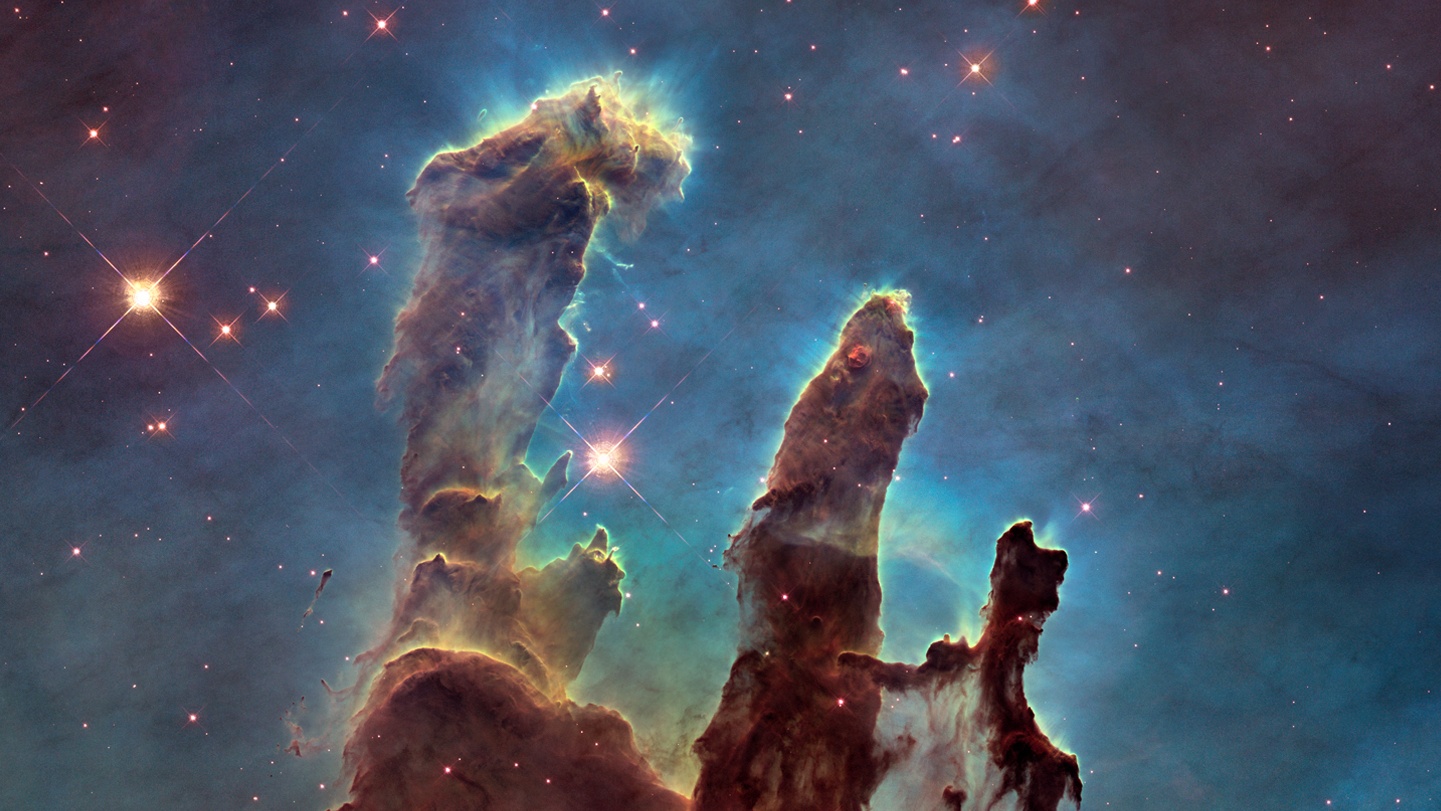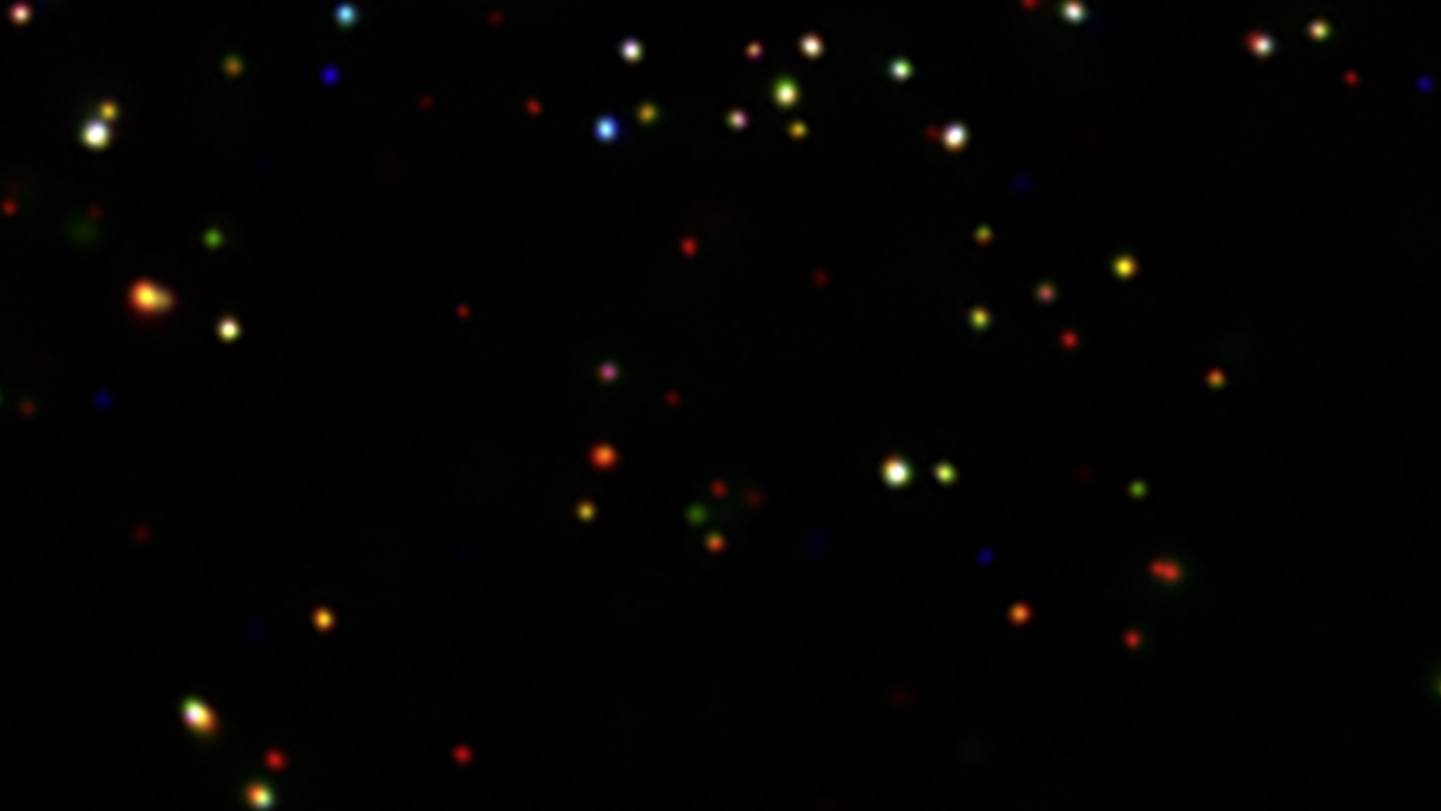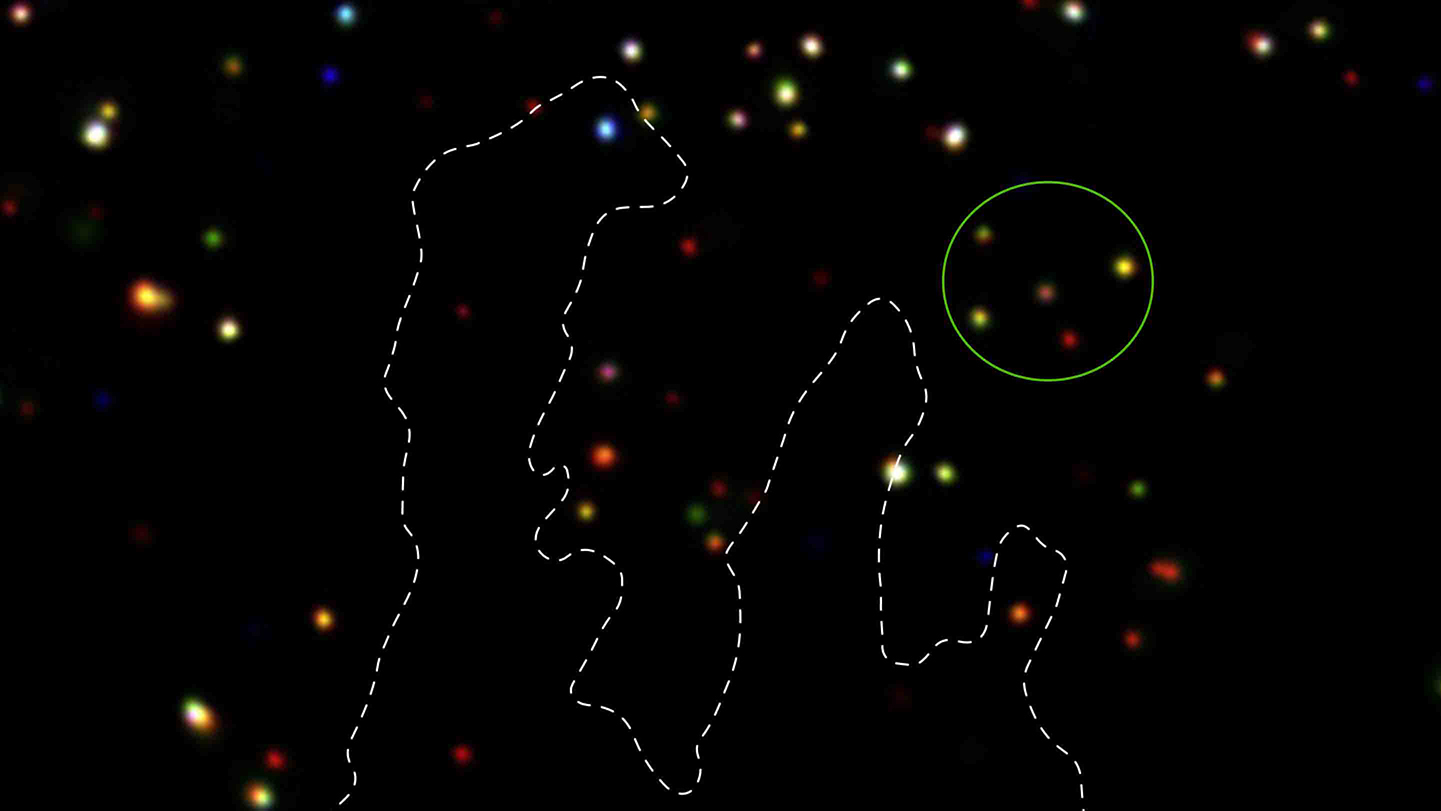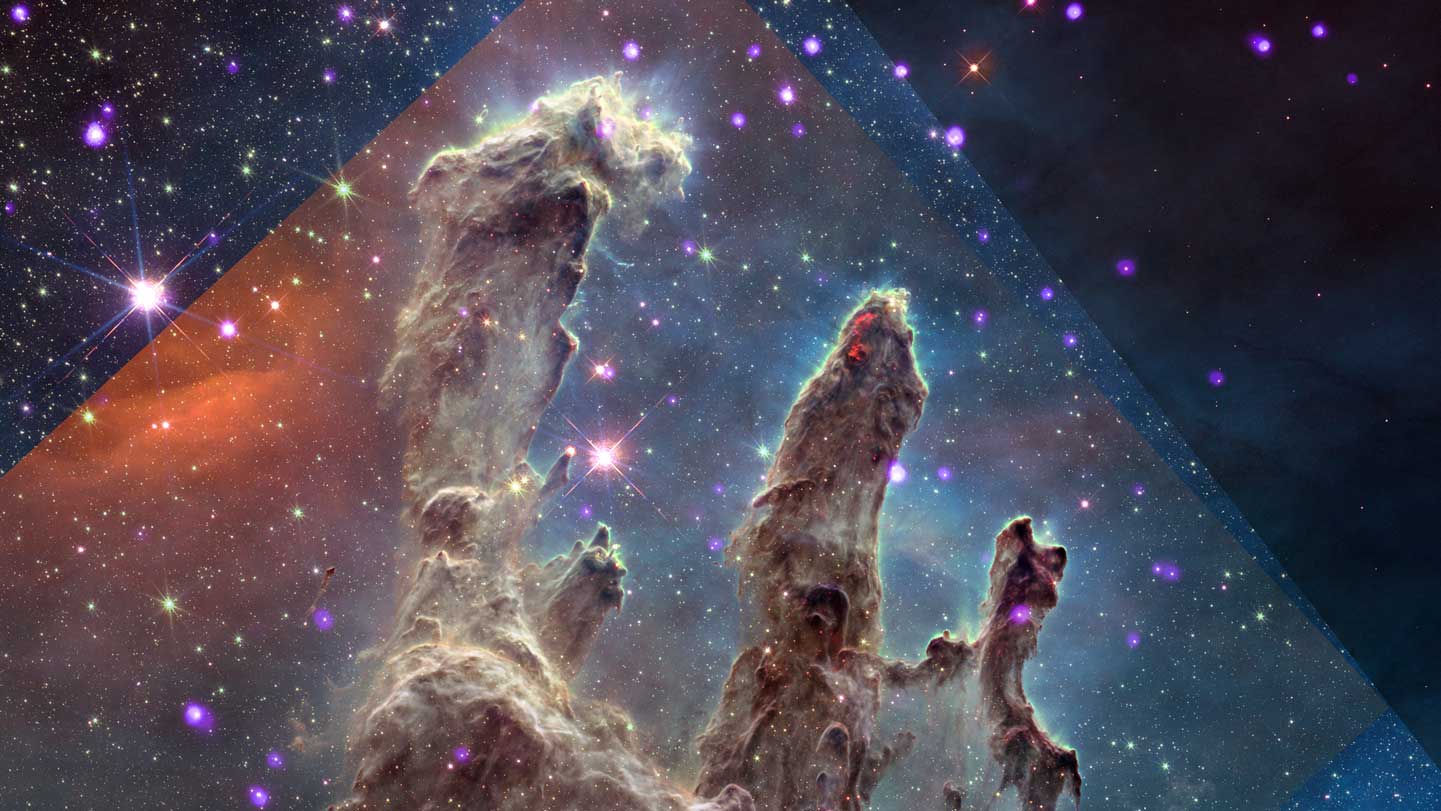Interactive Overview
Slider Interactive: A series of the same portion of the Eagle Nebula’s Pillars of Creation seen in different kinds of light. Below the caption is a horizontal slider bar with five labeled stops and a solid white circle. Dragging the white circle right and left along the slider bar causes elements of the image, labels, and caption to change. The change occurs gradually as one image, along with its associated caption and labels, fades out and the next fades in. A toggle button to the upper right of the image turns the image labels off and on. Some labels are in the form of text with arrows pointing to specific features in the image. Other labels are graphic overlays.
Slider Stops
From left to right, the slider stops are labeled: Mid-infrared, Near-infrared, Visible, X-ray, and Multi-wavelength.
Summary of Slider Stops
Sliding left to right reveals the following:
- “Mid-infrared” stop shows the dusty environment that comprises and surrounds the Eagle Nebula’s Pillars of Creation.
- “Near-infrared” stop reveals many of the stars that are scattered in front of, behind, and within the Eagle Nebula, though heavy areas of dust and gas are still present.
- “Visible” stop shows a reduction in the number of stars seen in visible light, with the pillars of gas and dust blocking the majority of stars. This is the initial image shown when the interactive is loaded.
- “X-ray” stop shows a colorful and blurry collection of fuzzy dots, which represents high-energy X-ray light emitted by stars.
- “Multi-wavelength” stop shows a composite of all the interactive’s wavelengths.
Stop 1: Mid-infrared
Image Description: Mid-infrared
Three thick brown asymmetrical columns are in the center, the tallest on the left and the shortest on the right, and resemble plumes of smoke that range from light to dark gray in color. The background is mostly orange, with the left area being the brightest before gradually becoming darker moving toward the right. Black triangles are in the upper left and right corners of the image due to the sensor’s field of view. Small white and orange points are scattered across this swath of space, including some among the pillars.
Labels: Mid-infrared
There are three text labels. The background, which is bright orange on the left, is labeled “Warm Dust.” A glowing red point near the tallest column’s edge is labeled “New Star.” The top of the shortest pillar is labeled “Dense Dust.”
Caption: Mid-infrared
Stars fade and dust structure shines in longer wavelengths.
Stop 2: Near-infrared
Image Description: Near-infrared
This image reveals the same patch of sky, now seen in near-infrared light. Thousands of white and yellow points, some with diffraction spikes, are heavily scattered throughout the image. The three asymmetrical columns in the center continue to resemble plumes of smoke, but are lighter in color compared to the prior “Mid-infrared” stop, ranging from light yellow to dark brown. Fuzzy light yellow and white areas surround the left pillar’s top and bottom areas. The middle and right pillars have small, lava-like red areas at their tops. Most of the background is blue, with the areas near the columns having a lighter shade than the environment further away. A black triangle is in the upper right corner of the image due to the sensor’s field of view.
Labels: Near-infrared
There are two text labels. The fuzzy, light blue area toward the top of the tallest pillar is labeled “Hot Gas.” The top reddish area of the middle pillar is labeled “Embedded Protostar.”
Caption: Near-infrared
Thousands more young stars shine through the nebula’s warm, glowing dust.
Stop 3: Visible
Image Description: Visible
This image reveals the same patch of sky, now seen in visible light. Many of the points of light seen in the “Near-infrared” stop are now shrouded by gas and dust. The dark brown pillars are outlined by a light yellow-green glow, with thin streaks of glowing material radiating out from their edges. The background is blue, with the area near the columns having a lighter shade than the environment further away. Many small red dots and a few larger light orange points with diffraction spikes are scattered across this swath of space, including some small red circles seen near and in front of the pillars.
Labels: Visible
There are two text labels. The yellow-green glow surrounding the tallest pillar’s top is labeled “Gas streamers from stellar wind.” The middle pillar is labeled “Pillar of gas and dust.”
Caption: Visible
Forming stars nestle inside dense cocoons of gas and dust, which block their visible light from reaching the telescope.
Stop 4: X-ray
Image Description: X-ray
This image reveals the same patch of sky, now seen in X-ray light. The view is mostly black. Colorful, blurry dots in various colors are dispersed thinly across the scene, most lying outside the pillars: red, pink, yellow, orange, green, blue, and white. The pillars themselves cannot be seen at all.
Labels: X-ray
There is one text label and two graphic overlays. A white dashed line outlines the general shape of the three pillars. A large green circle toward the upper right section just outside the pillars’ outline is labeled “Young active stars.”
Caption: X-ray
Most of the stars emitting high-energy X-ray light in the nebula are outside the pillars.
Stop 5: Multi-wavelength
Image Description: Multi-wavelength
This image is a composite of all the wavelengths explored in other stops of the interactive. The Eagle Nebula’s Pillars of Creation and the immediate surrounding area include all the interactive’s views of light. The views do not overlap at the edges of the image—the upper left and right corners—due to the sensors’ differing imaging fields of view. This creates diagonal bands that diverge in color and detail. The pillars are smoke-like plumes of light and dark brown. The edges of the pillars’ tops have a white and light green glow, with thin streaks of glowing material radiating from their edges. The left pillar (the tallest) is lighter in color compared to the middle and right pillars. The latter two have small, lava-like red areas near their tops. Points of different sizes and shapes, some with diffraction spikes, are densely scattered across the background and among the pillars in various colors: red, orange, green, purple, and white.
Labels: Multi-wavelength
There are three text labels. A light pink point on the edge of the left pillar is labeled “Emerging star.” The dark colored area of the right pillar is labeled “Dense, dark dust.” A small purple dot toward the upper right of the pillars is labeled “High-energy star.”
Caption: Multi-wavelength
Radiation from hot young stars shapes the pillars via erosion, while also sweeping up gas for gravity to compact into new stars.
